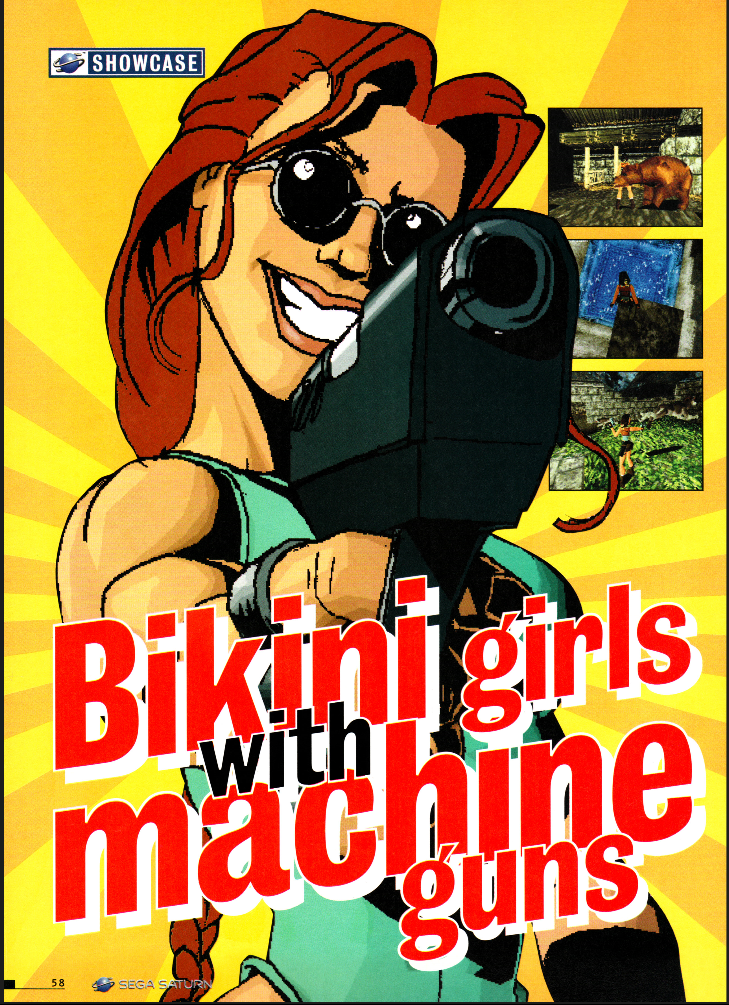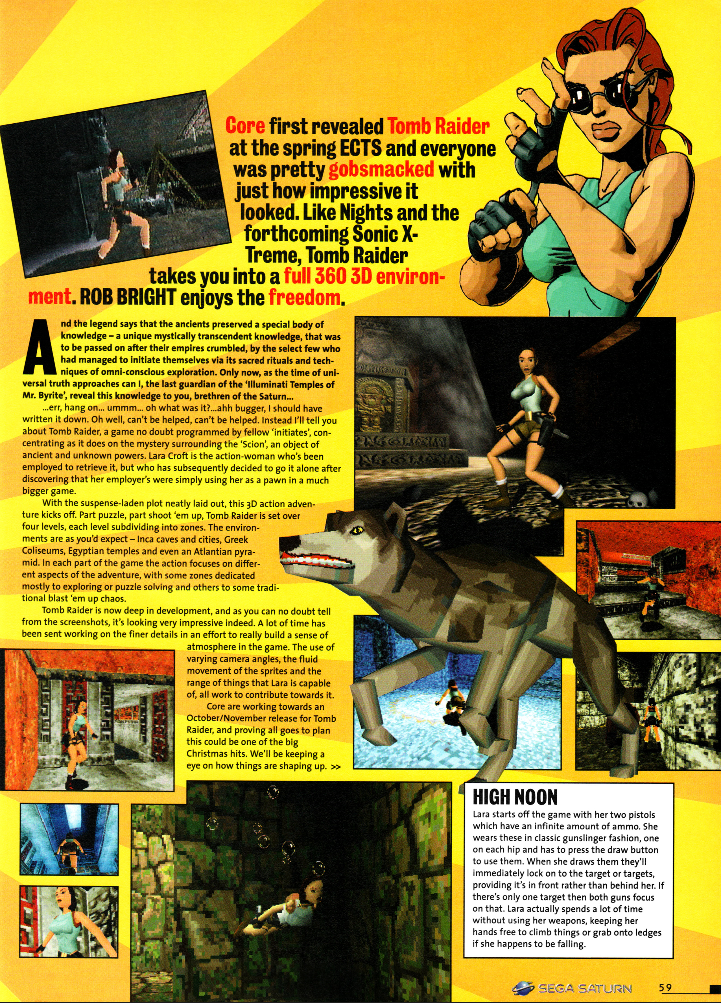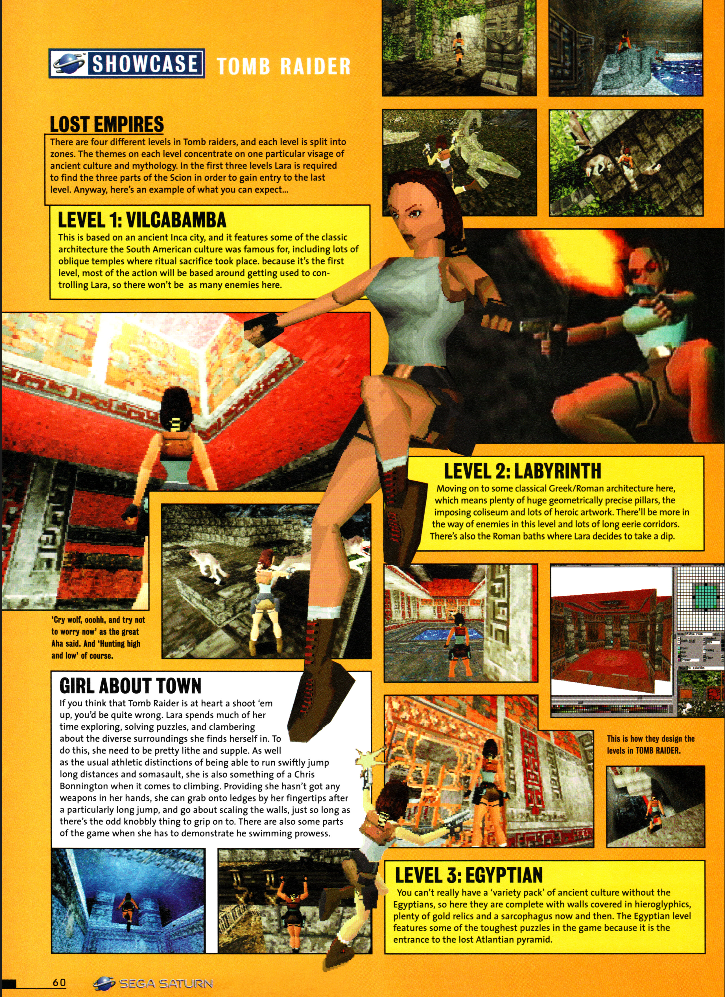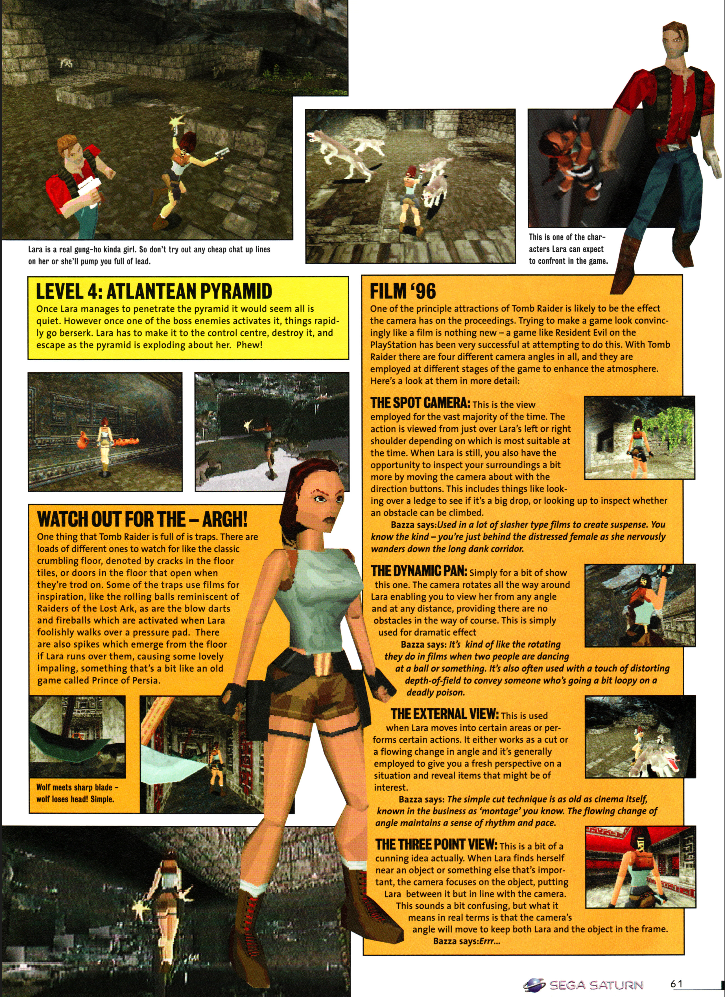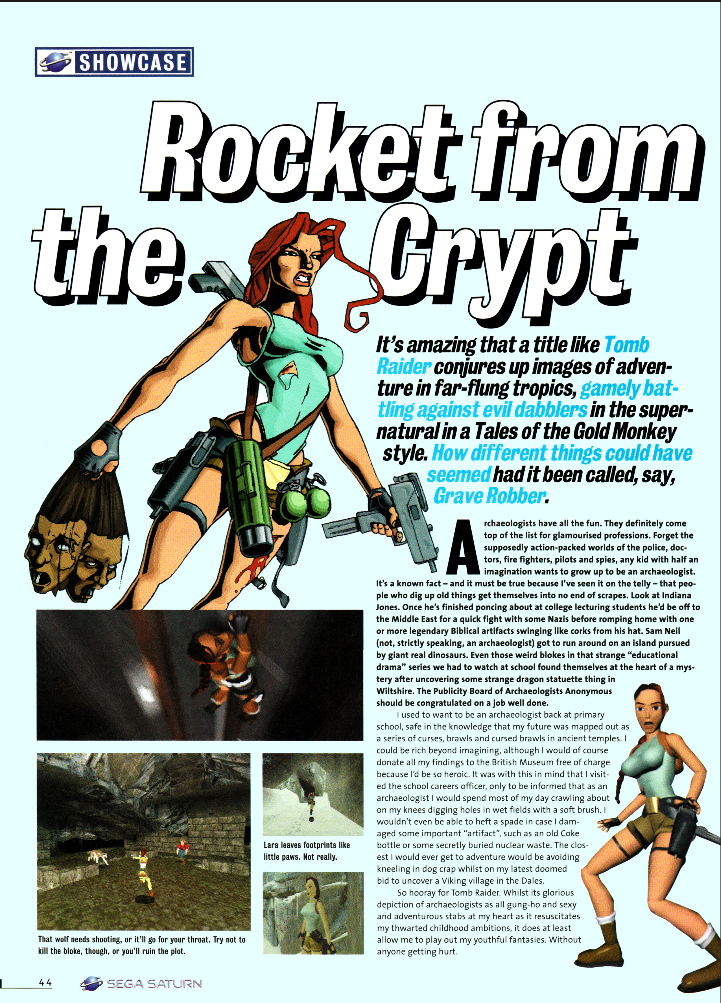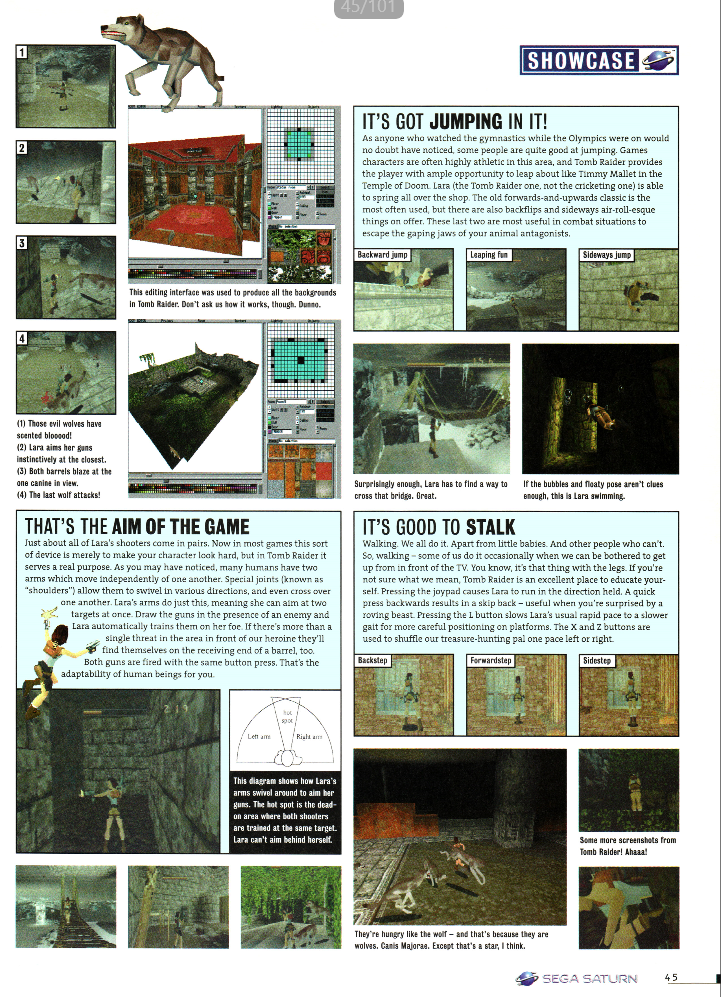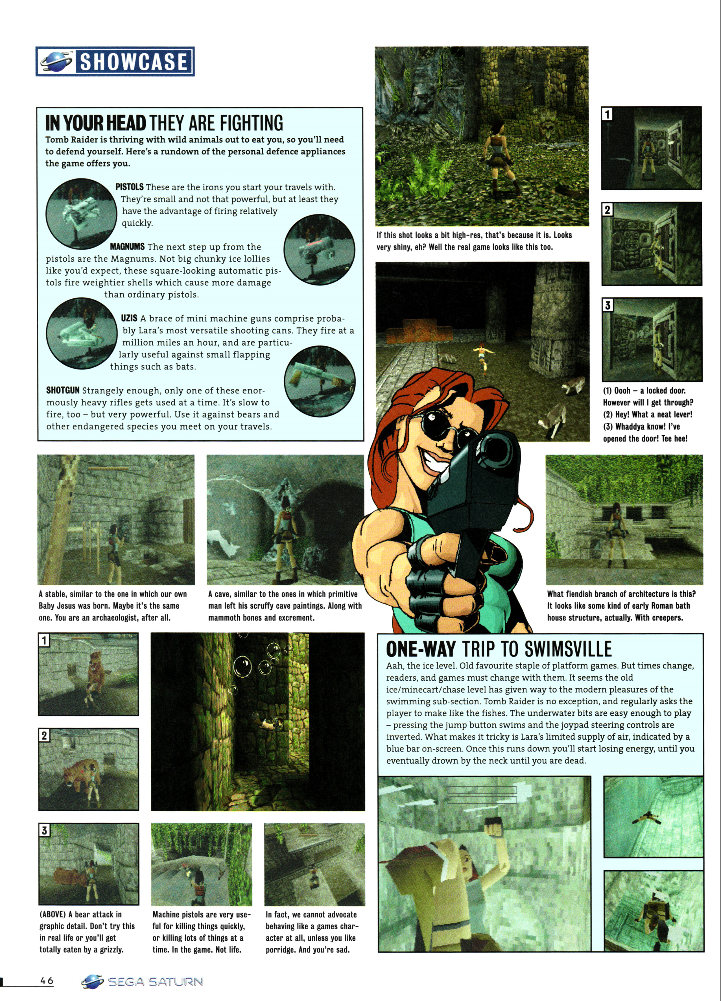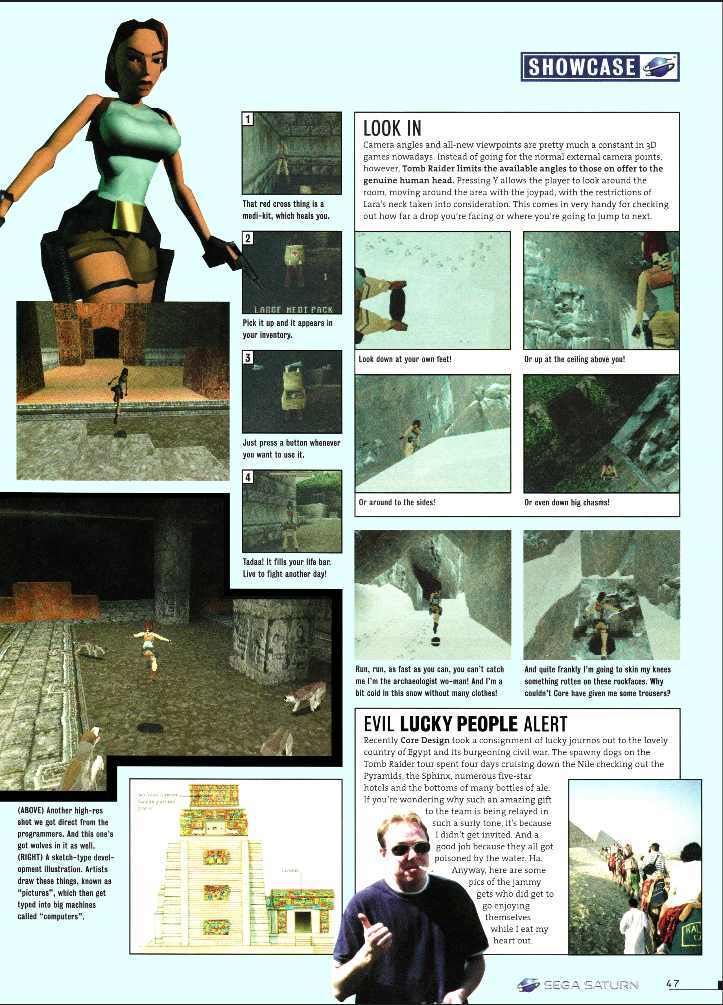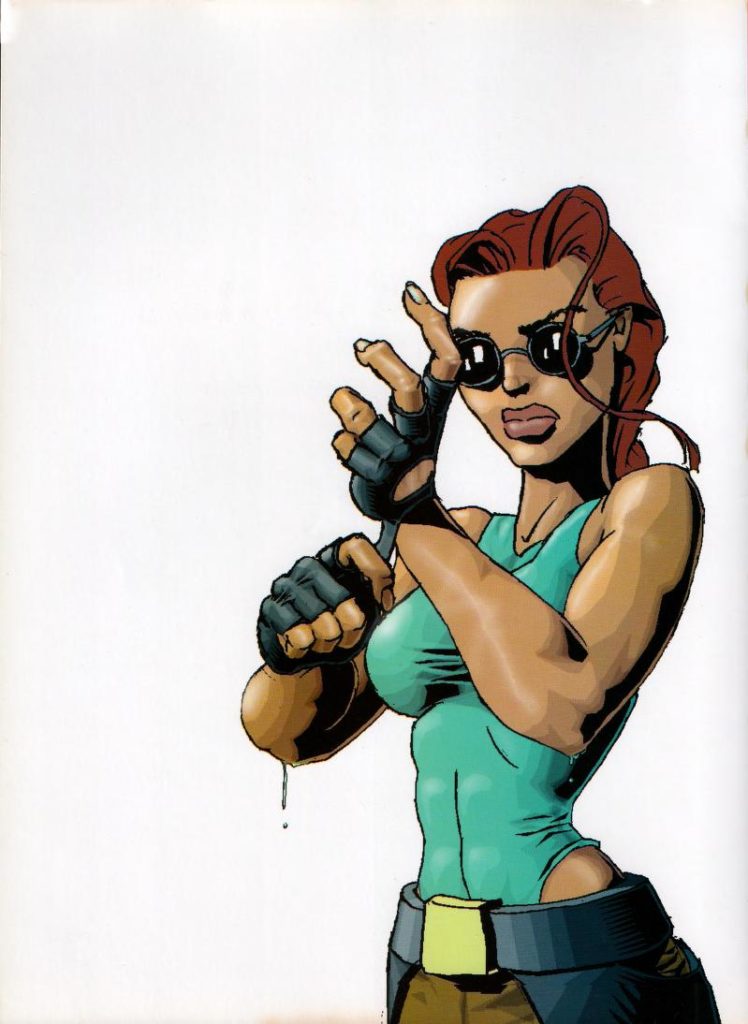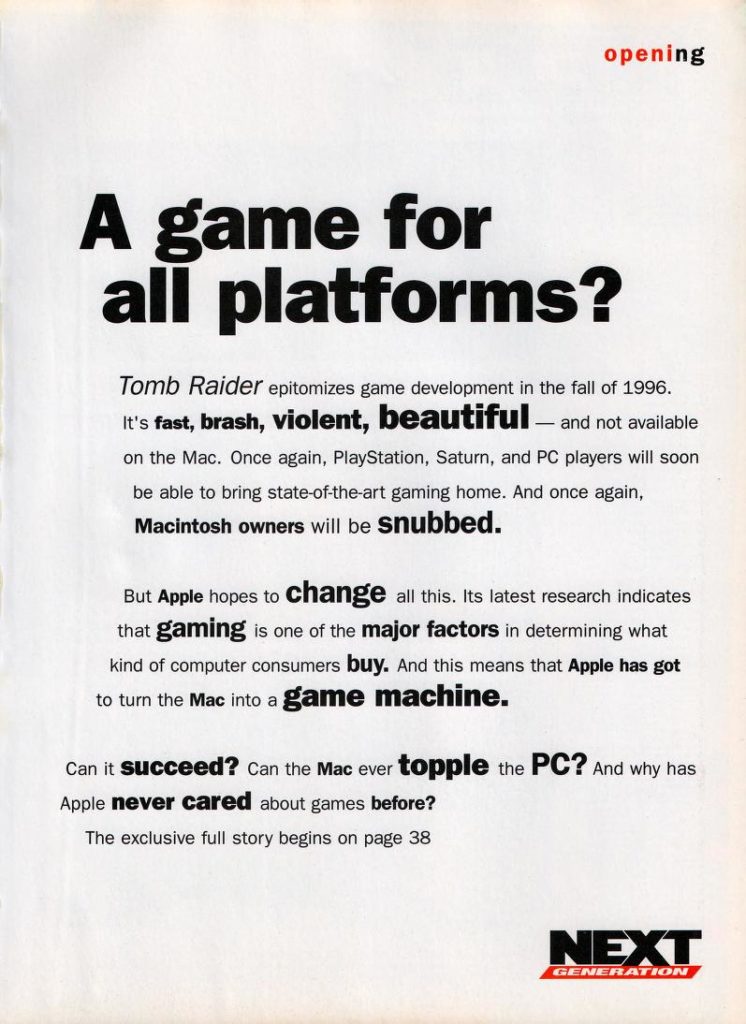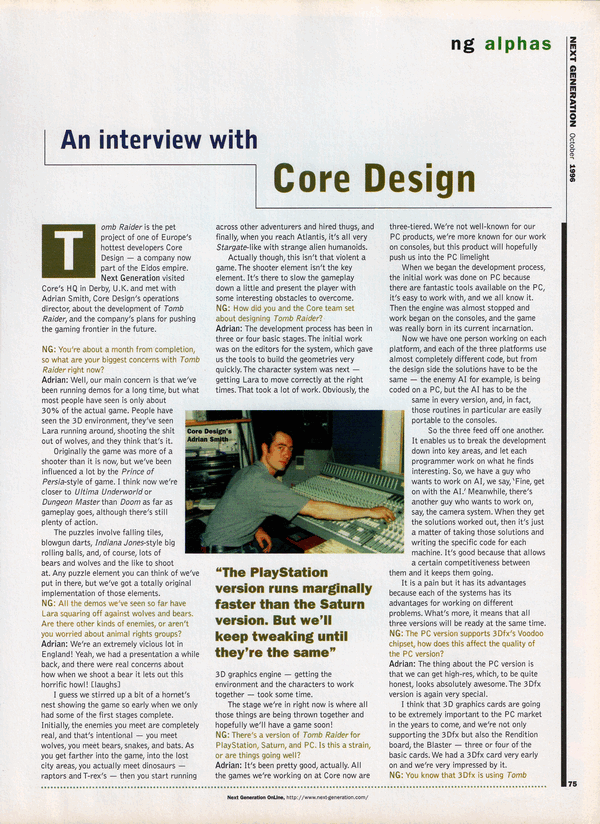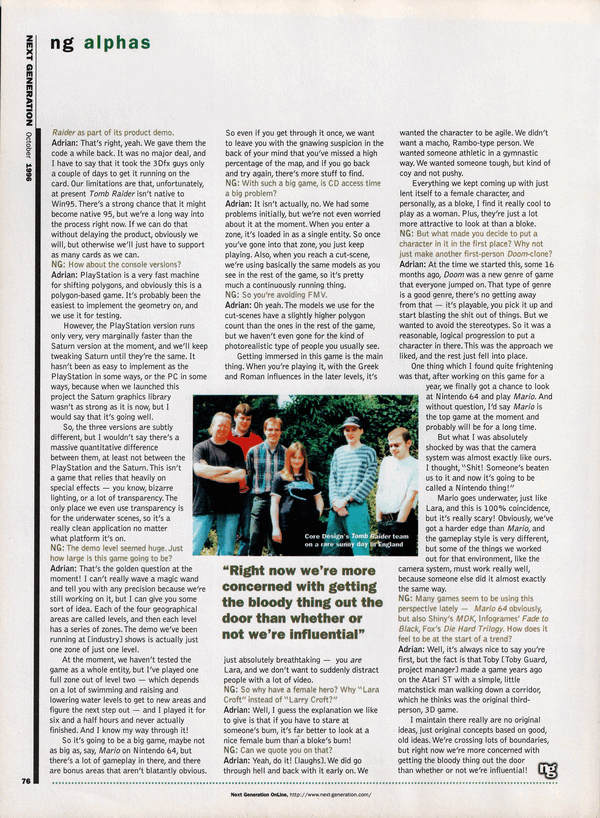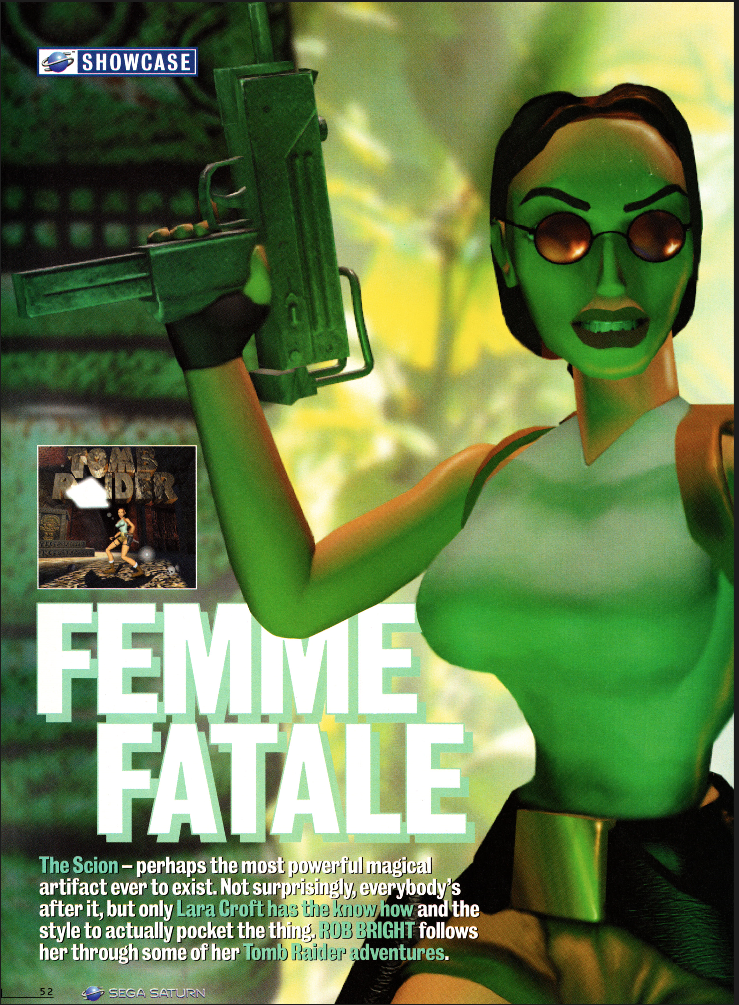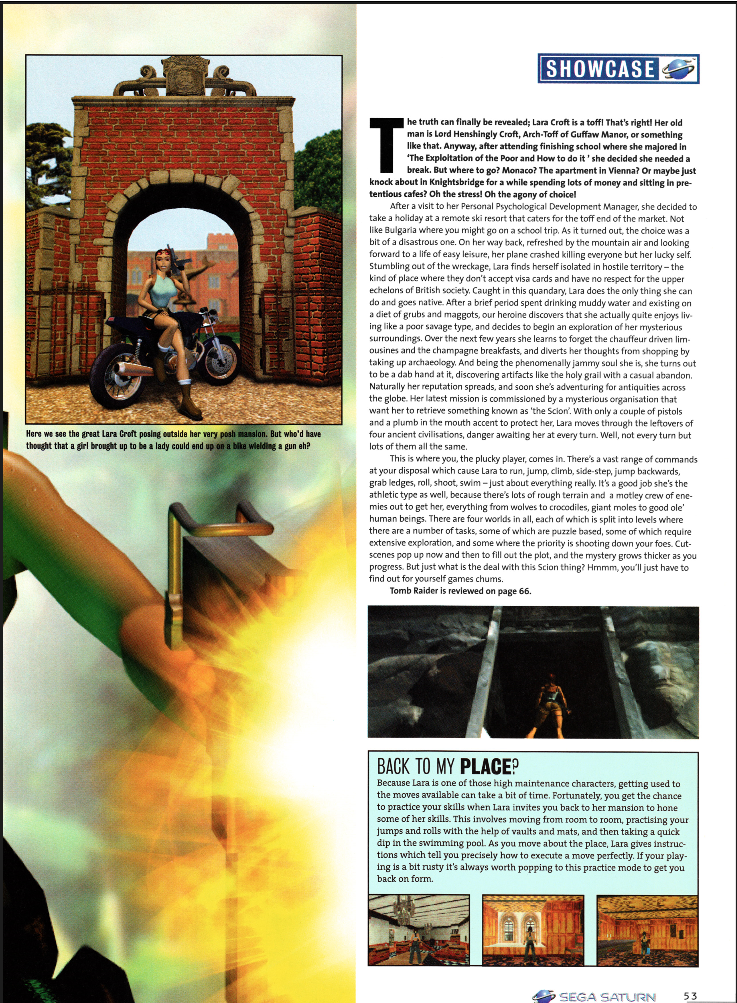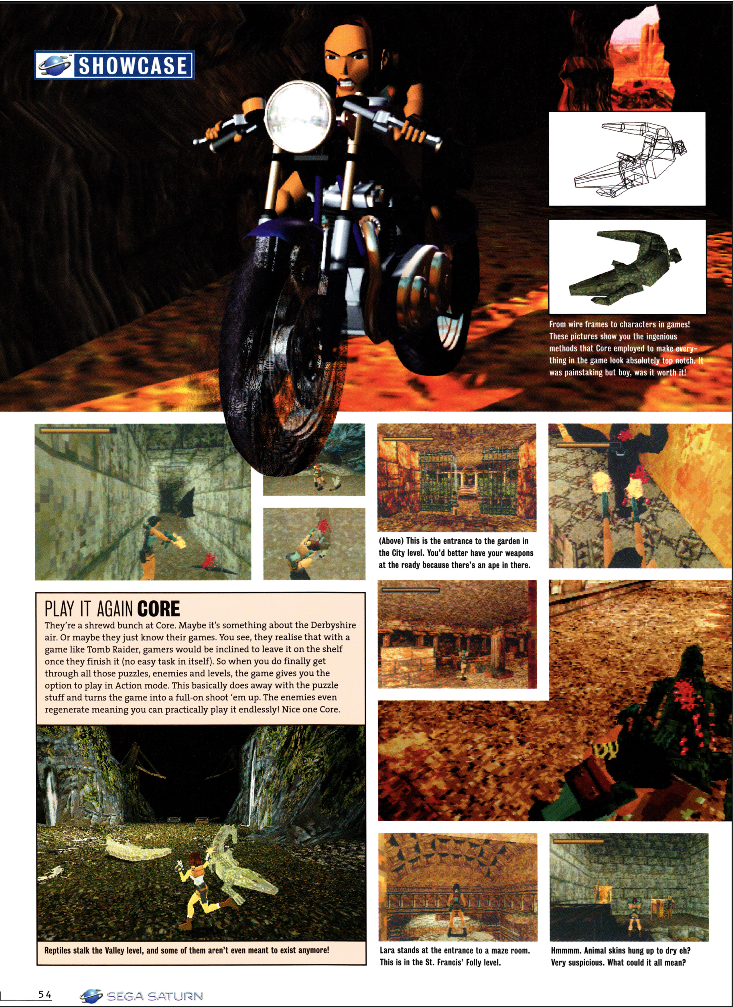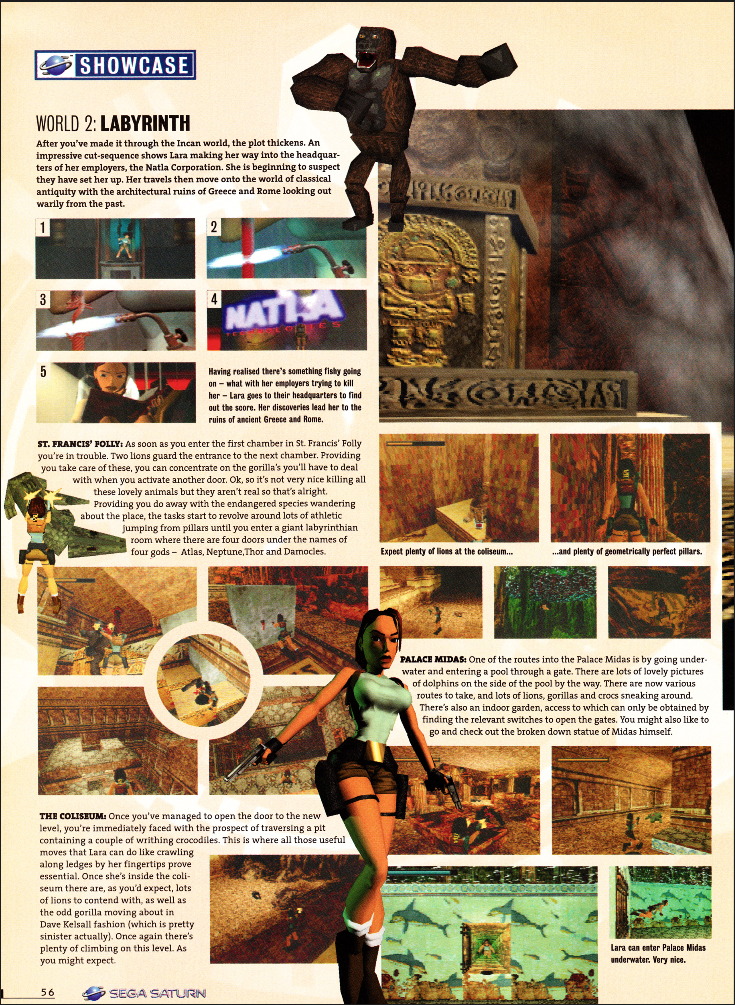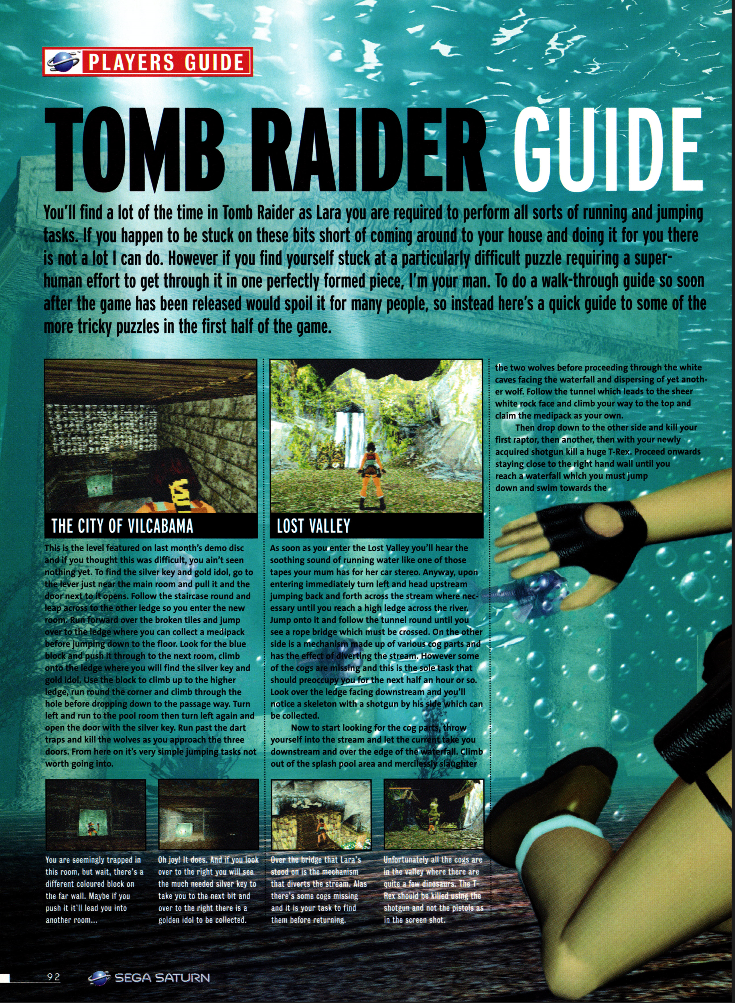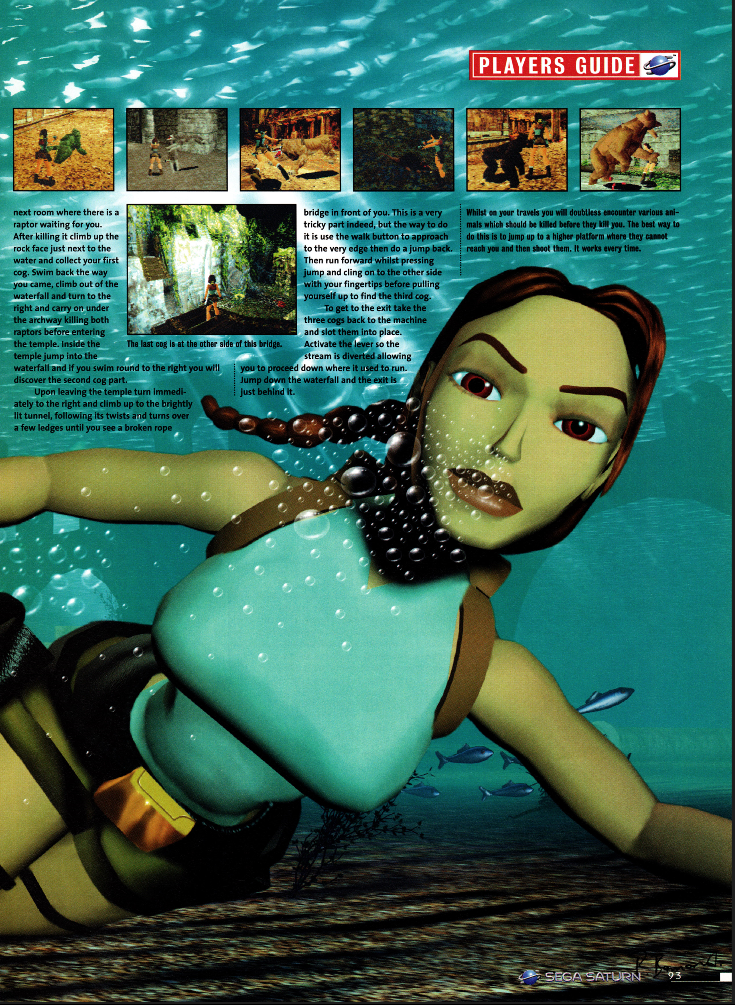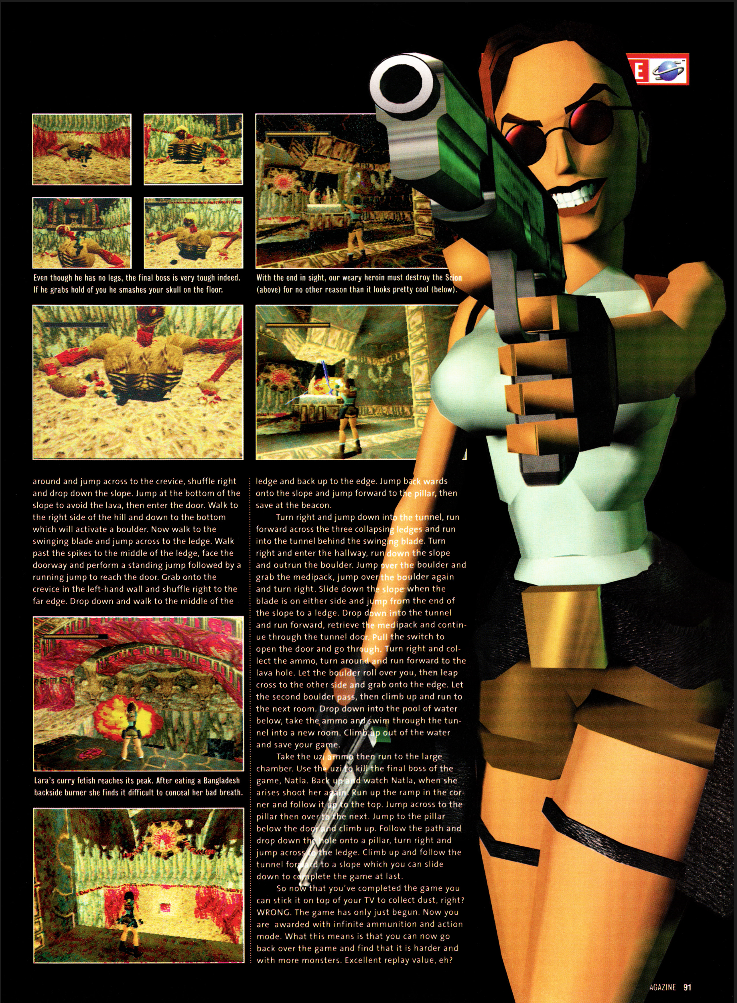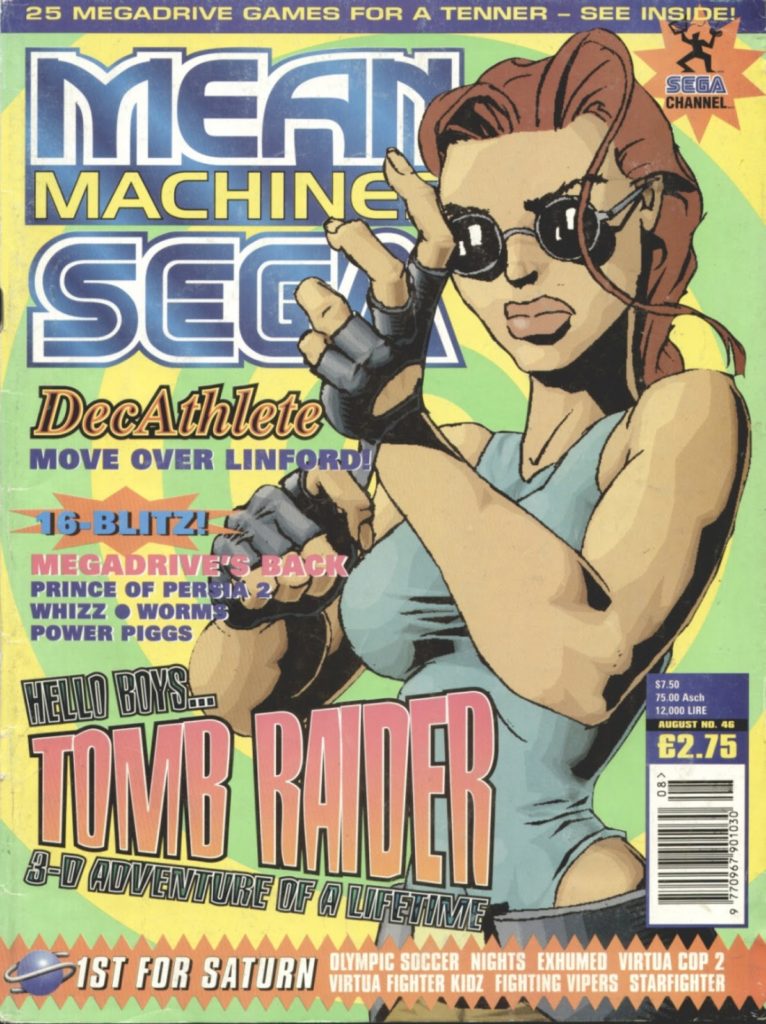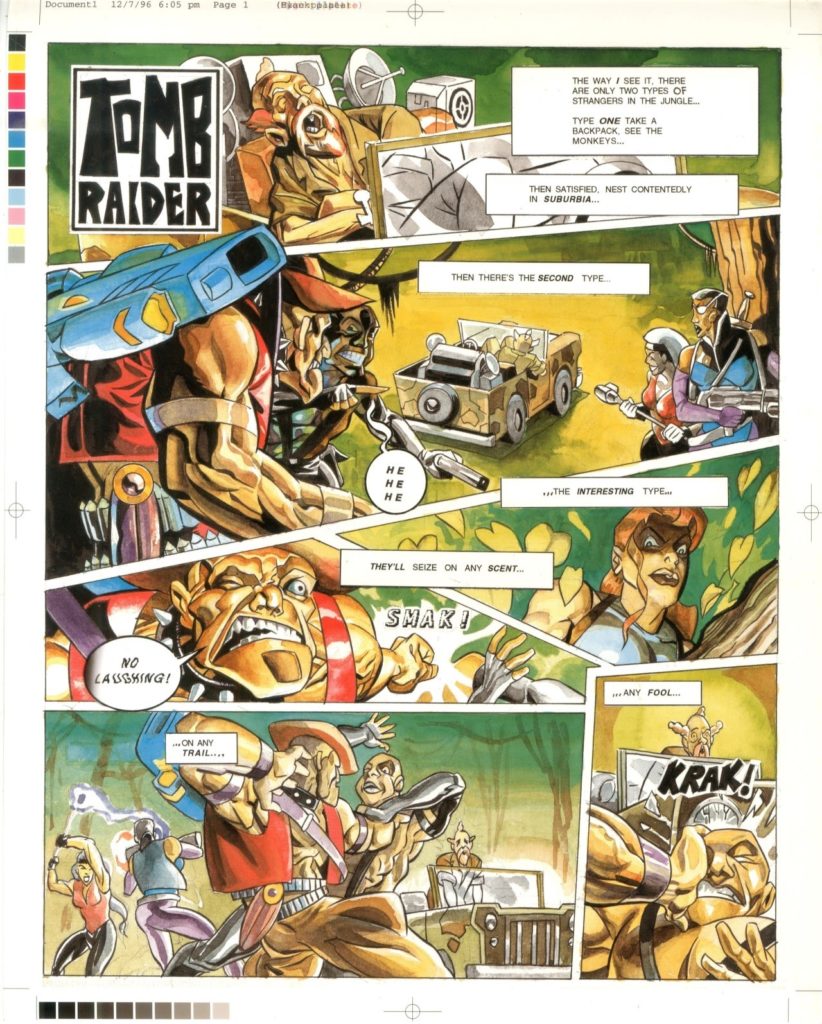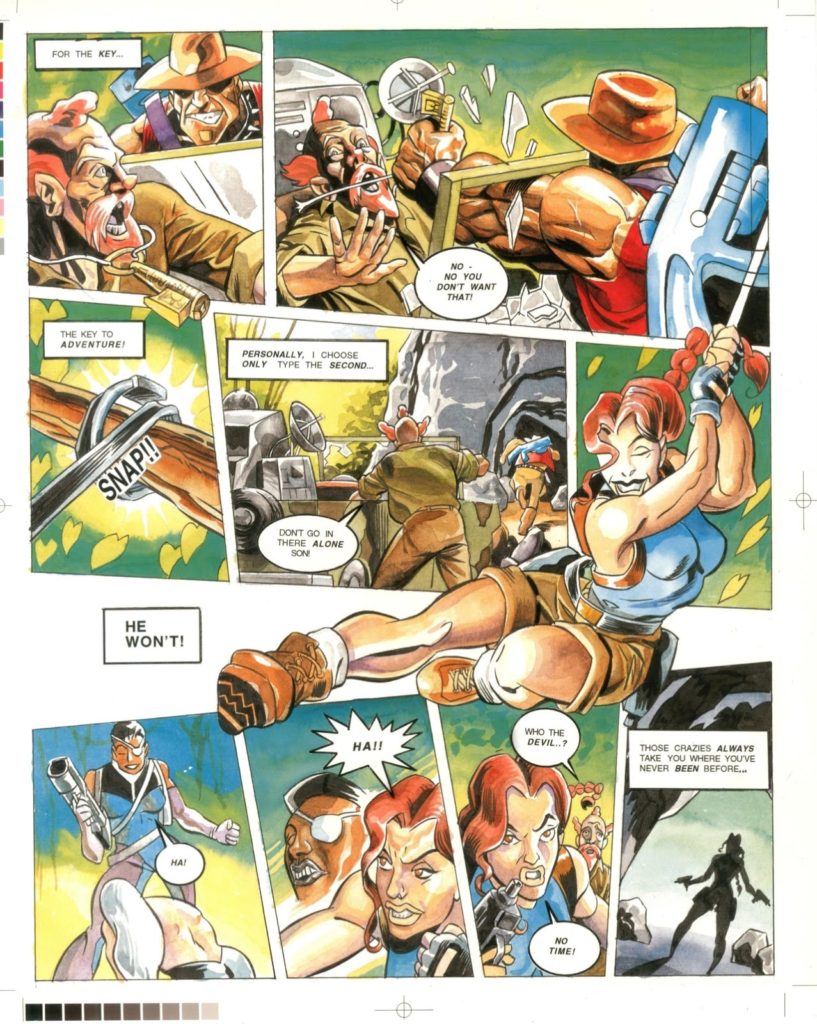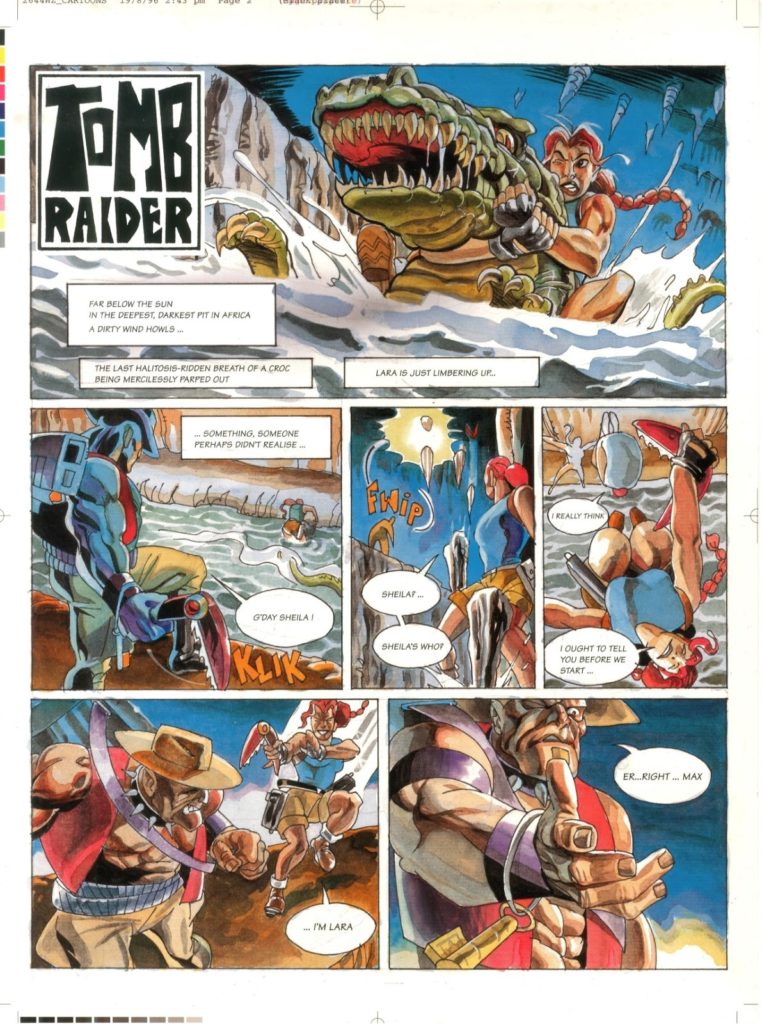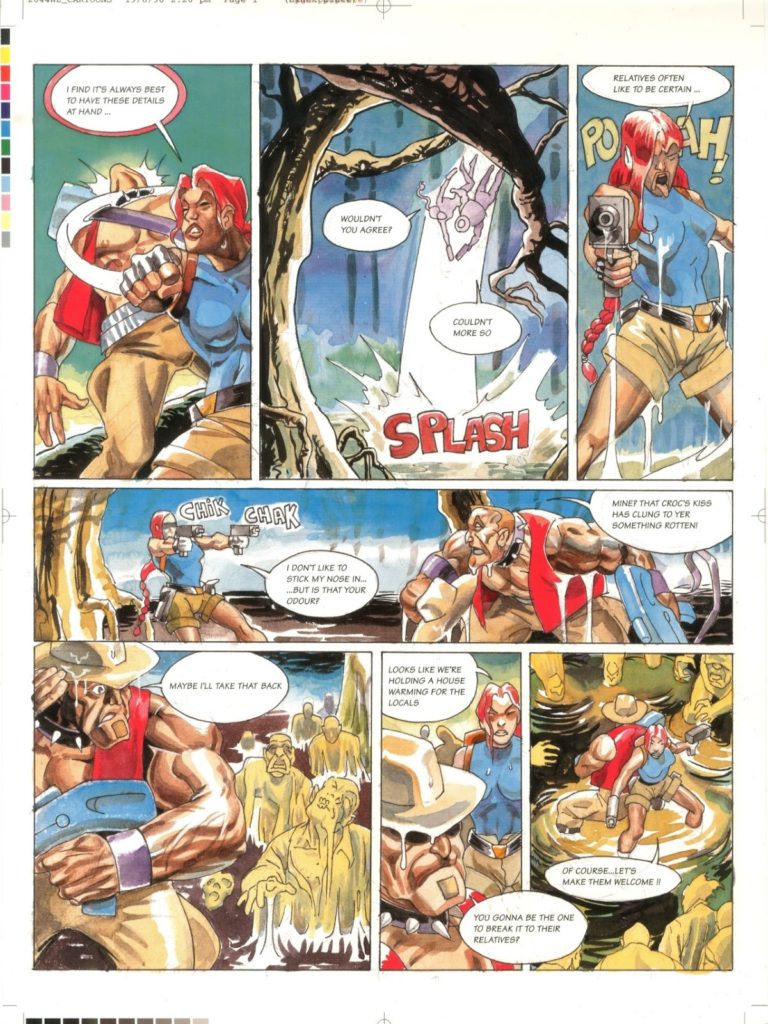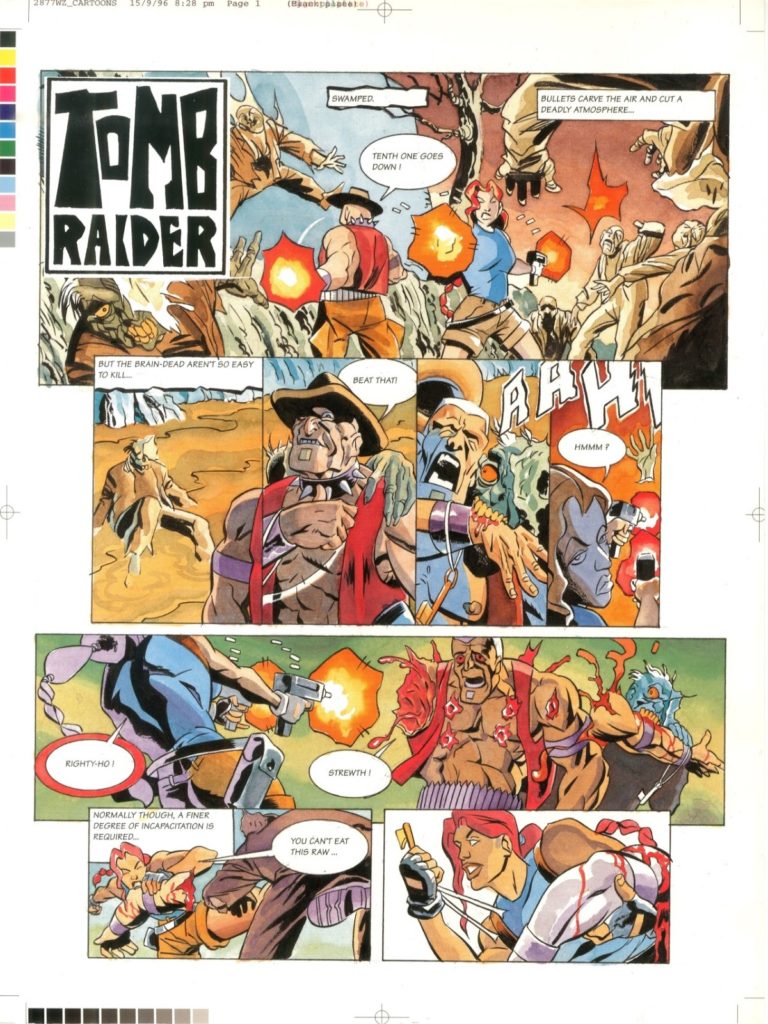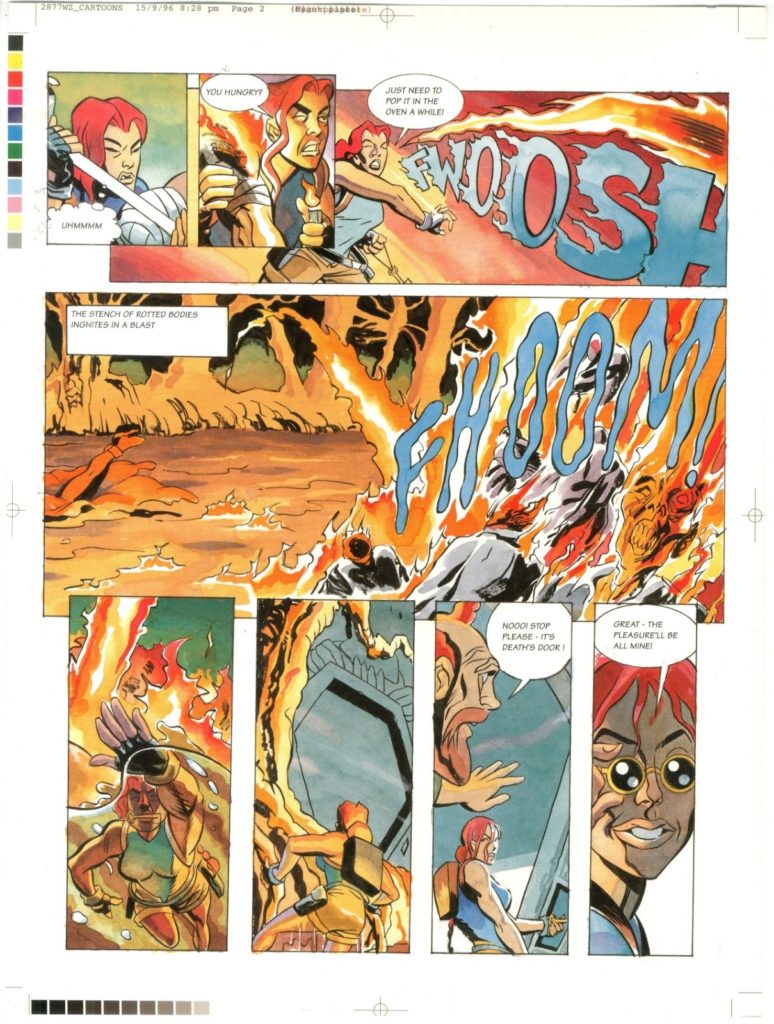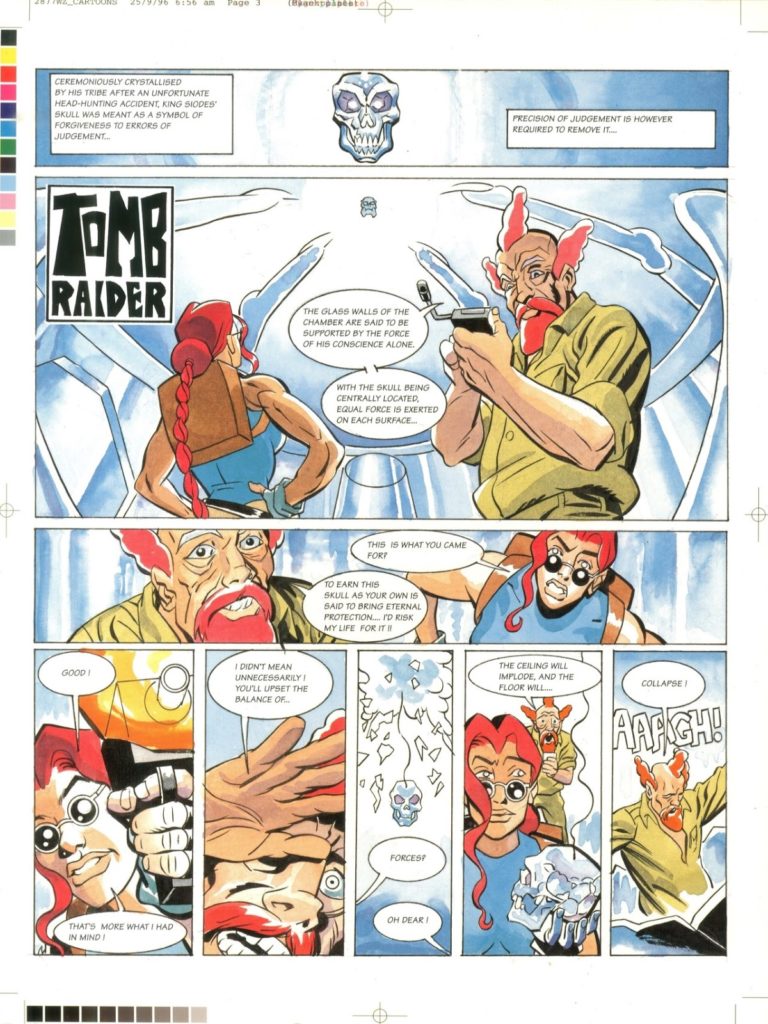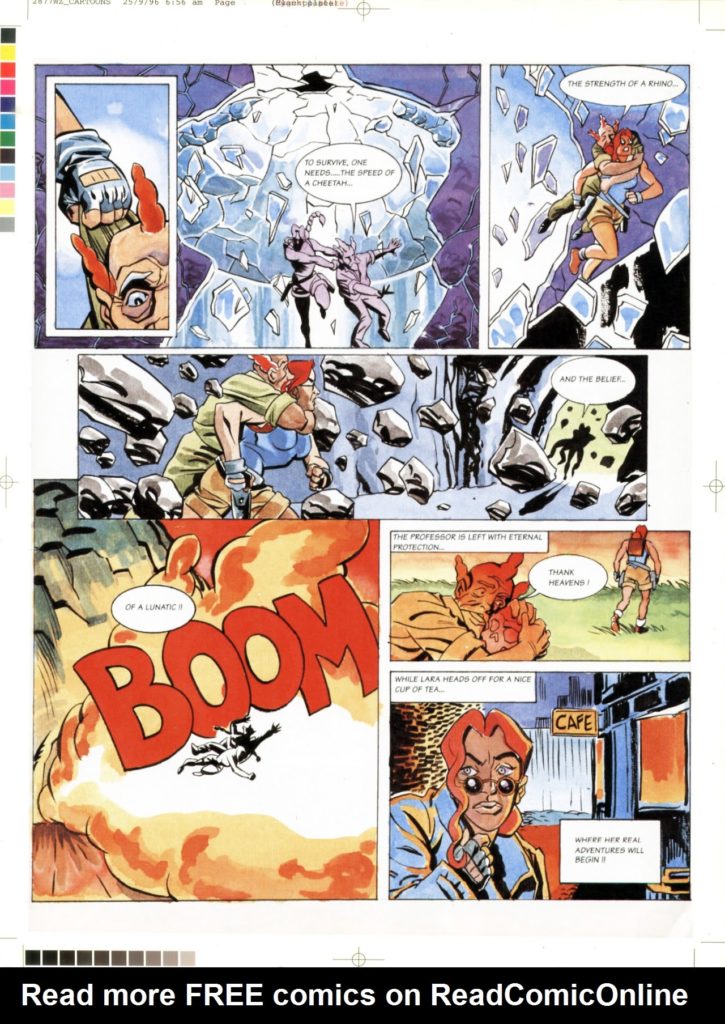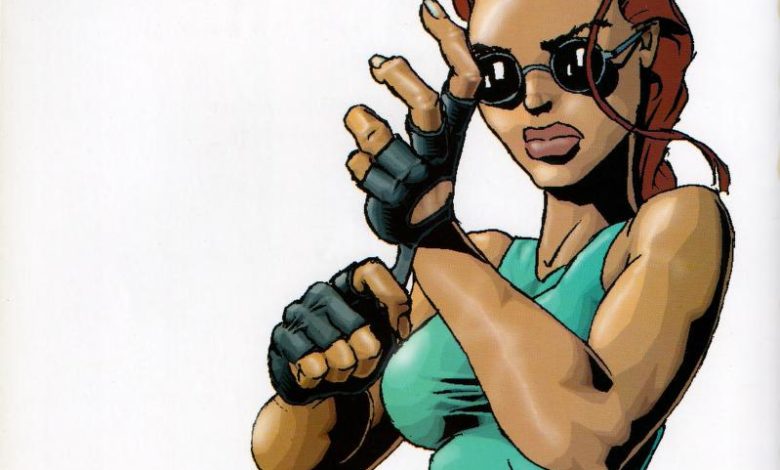
Tomb Raider and Lara Croft’s chronicles on print media – Part 1
Core Design and SEGA go way back. Their relationship started on the Mega Drive, continuing on with every add-on and home console until SEGA exited the hardware business. Their productions were often graphical powerhouses, showing what the consoles were capable of. Of their entire SEGA library, none are so fondly, or bitterly, remembered as the Tomb Raider games.
Though Tomb Raider proved that the Saturn could indeed “do 3D”, and Tomb Raider IV: The Last Revelation did benefit from hardware specific upgrades on the Dreamcast, SEGA fans never really got the franchise at its best – or rather, as good as it could have been. Looking back at print media covering the games, the series’ successes and shortcomings on SEGA hardware are made evident. The following is a tour through the franchise’s evolution, and the main character’s pop culture life, as it existed and thrived in physical print media.
Tomb Raider
When Tomb Raider was first showcased in SEGA Saturn Magazine (SSM) #8, they praised the game’s full 3D environments (Saturn does 3D all the time, no big deal) and described the main character, Lara Croft, as a “grungified glamor girl with a gun who has an affinity for lots of nice shiny things. You know, the average kind of nineties girl”.[1] Overall, the tone of the article was (in retrospect) surprisingly nonchalant. There was little inclination that this game would not only be a huge deal for the Saturn, nor that it would very quickly become a worldwide phenomenon.
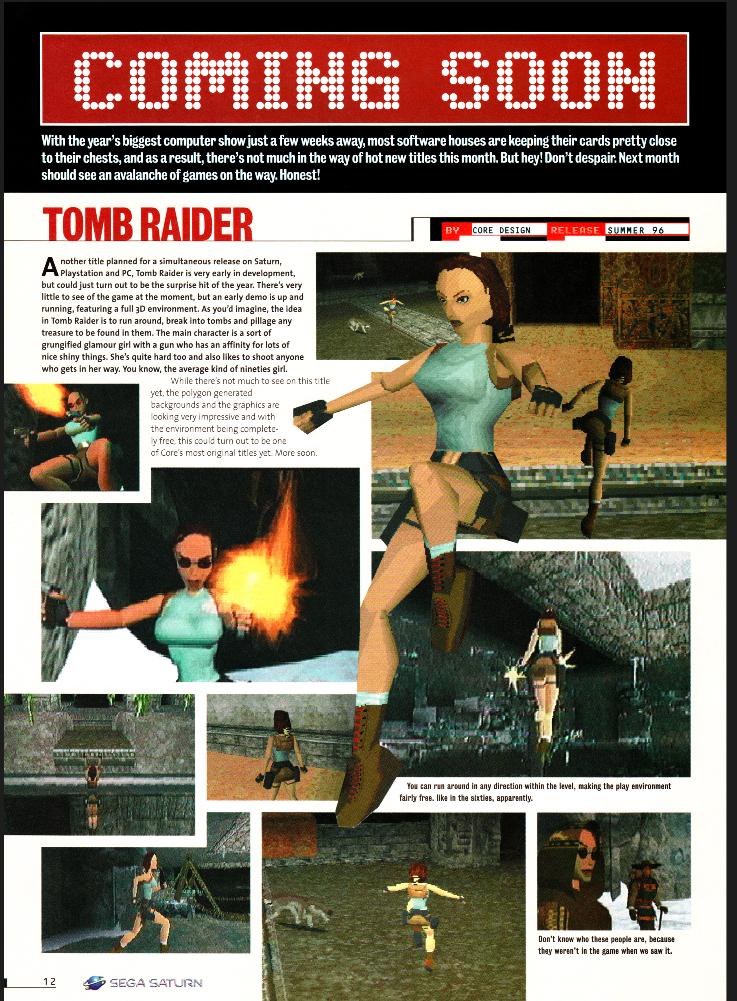
In SSM #10, Rob Bright previewed the game. The article, titled “Bikini girls with machine guns”, went to considerable length to describe exactly what type of game Tomb Raider was. Bright touted the 3D architecture, comparing the graphics to the “forthcoming” Sonic X-treme (RIP) and Nights: Into Dreams.[2] A large polygonal model of Croft featured in the centre of the page, proudly showing off how good the game looked.[3]
Bright explored the gameplay rhythm of Tomb Raider in his preview, stressing that it was not a shoot ‘em up by highlighting Croft’s abilities in game, like swimming, climbing, and running.[4] He described how combat would be auto-lock based, with mobility the focus more so than aiming; a dynamic camera switching between a myriad of cinematic angles to best score the action on screen.[5]
The number of gameplay systems utilized by Tomb Raider came off as almost staggering, and fitting all the details into the preview appears to have been a tricky task, with screenshots arranged like puzzle pieces throughout the pages. While action-adventure is an established genre nowadays, the idea of equipping a character with so many different abilities back in 1996 was a bold prospect. Bright finished with stating, “This could be one of the big Christmas hits.”[6]
The game was previewed yet again in SSM #12. Here, Croft’s move set was broken down in detail, showcasing how she was able to circumvent the game’s complex environments.[7] An early build of the Tomb Raider Level Editor can be seen in the background of one of the article’s photographs, which Core Design would refine and use to build a total of five Tomb Raider games.[8]
As part of a promotion for the game, Eidos sent a group of games journalists to Egypt, though SSM didn’t get to go (which turned out to be alright, as everyone got food poisoning).[9] Indigestion aside, the hype for Tomb Raider was alive, and it’s clear Saturn owners were eager to get their hands on the game just as much as their PlayStation and PC gamer counterparts.
In Next Generation Magazine (Oct. 1996), Core Design Operations Director Adrian Smith was interviewed. He offered some insight into the game’s development, stating, “Originally the game was more of a shooter than it is now, but we’ve been influenced a lot by the Prince of Persia-style of game,” describing the design having moved from mirroring Doom to Ultima Underworld as development proceeded. [10]


“We’re not well-known for our PC products, we’re more known for our work on consoles, but this product will hopefully push us into the PC limelight.” – Adrian Smith
Smith also opened up about developing the game for three different platforms: PC, PlayStation, and Saturn. While Tomb Raider moved more than its fair share of 3DFX cards, the game also had to run on consoles, and this meant it had to be programmed and designed separately for each platform. When building the Saturn version, Smith confessed, “It (the Saturn version) hasn’t been as easy to implement as the PlayStation in some ways, or the PC in some ways, because when we launched this project the Saturn graphics library wasn’t as strong as it is now, but I would say it is going well.”[11] He also mentioned that the PlayStation version ran marginally faster than the Saturn, though stated they would work to close that gap before the game launched.
Finally, Smith offered some information about the game’s character – specifically, why Lara and not Larry? “Well, I guess the explanation we like to give is that if you have to stare at someone’s bum, it’s far better to look at a nice female bum than a bloke’s bum!”[12] Nowadays, Croft is viewed as such a ground-breaking character, having served as a gateway avatar for so many non-gamers to enter the hobby. Yet, here, it seems Core Design had no inkling as to their heroine’s mass appeal.
Tomb Raider landed on the Saturn on October 26, 1996. SSM #13 dedicated a whopping eight pages to the game, starting with Bright’s “Femme Fatal” article, giving players some insight as to who Croft was behind the scenes. Pictured outside her Surry manor sitting atop a motorcycle and holding a pistol, Croft was portrayed as both posh and capable, her refinement matched by attitude and knowhow.[13] The adventure first started when Croft’s plane crashed in the Himalayas, leaving her stranded for several days before being rescued. Here, she developed a taste for adventure, ultimately making her into the fiercely independent woman we come to play as in the game.
Scoring 92%, it’s clear that SSM didn’t waste all those months (and paper) hyping the game up. The article began by reminiscing about SEGA and Core Design’s relationship over the years, with hits like Chuck Rock on the Mega Drive and Thunderhawk on the Mega-CD. There is a bit of ownership attached to the title by the publication, as Core Design had partnered with SEGA for a long time; more so, Tomb Raider had come to the Saturn first. In some gamer’s eyes, Croft was on her way to entering the SEGA pantheon.[15]
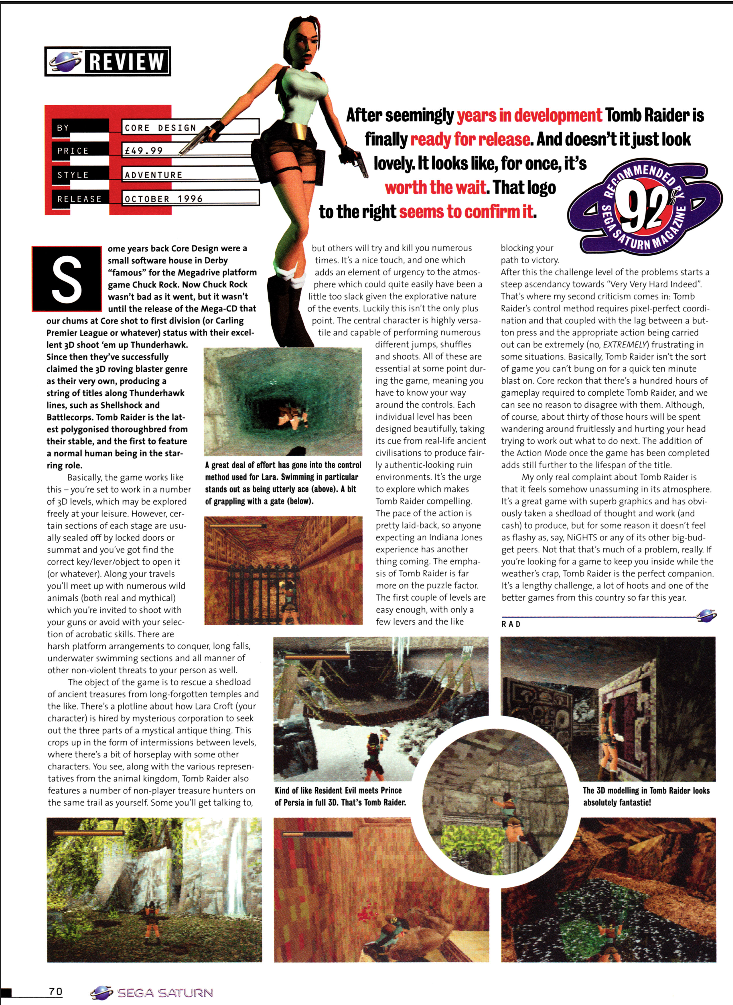
SSM gushed about the game’s detailed 3D models (though stated they’re not quite as pretty as those seen in Nights) and atmospheric sound design. They also stressed that the core theme of the game was puzzle solving, though the flow between action and exploration was well balanced. The controls, despite their initial complexity, were also praised. “A great deal of effort has gone into the control method for Lara. Swimming, in particular, stands out as being utterly ace.”[16]
However, SSM did note that much of the platforming required pixel-perfect detection, and a slight lag in the input could prove frustrating. Still, the feeling of accomplishment was undeniable.[17]
“There are harsh platform arrangements to conquer, long falls, underwater swimming sections and all manner of other non-violent threats to your person as well.”[18]
Lara-Mania was about to come into full swing, and SSM wasn’t going to just drop coverage of Croft’s adventures until the inevitable Tomb Raider II. Over the next four issues, SSM published guides for Tomb Raider, breaking the game down level by level, and sporting gorgeous full-page renders of Croft in the field. It wasn’t just the game that SSM wanted to feature, it was the game’s protagonist. Croft was becoming bigger than the Tomb Raider, and her smiling (or snarling) face seemed capable of moving copies of a magazine by itself. In total, SSM dedicated over two-dozen pages over the course of eight issues to Tomb Raider. That’s some serious ink.
SSM wasn’t the only SEGA-centric publication to claim Tomb Raider as their own. Mean Machines published a limited series comic book retelling the adventures of Croft leading up to the start of the first game. These two-page strips are full of action, showing Croft working both solo and with other tomb raiders. Though they aren’t considered canon, they perfectly suit the colorful and whacky take on adventure archaeology that Core Design was going for. The blocky character models have a great weight and movement to them, somewhat mirroring the polygonal look of the game. In Mean Machine’s eyes, Tomb Raider was a Saturn game first (literally and figuratively), and the only way to get the full scoop on Croft’s adventures was to buy their magazine and play the game on Saturn.
Ghosted
Despite the buzz created by Tomb Raider for the Saturn, the question as to whether Croft would return to the console soon became worrying. There would be a Tomb Raider II, that was certain. But on May 22, 1997, IGN reported that Sony may be vying for console exclusivity of the title.[1] The article pointed out that the Nintendo 64 was never under consideration for the title, and that the deal would allegedly not affect the PC release, leaving only two consoles on the table: The Saturn and PlayStation.
In Next Generation’s coverage of the story, they speculated that the reason for the (alleged) cancelation of Tomb Raider II on the Saturn was due to the console’s inability to process the vastly improved 3D graphics.[2] However, they pointed out that Core Design still had other 3D games in development for the console, including Fighting Force. The article ended with, “Others believe, however, that Sony is trying to tie down an exclusivity deal with Core which mean[sic] the game can only appear on PlayStation.”[3]
Despite Core Design and SEGA’s seemingly strong relationship, and the copious amount of ink SEGA-focused publications had dedicated to the first game, the rumours were soon proven true. Tomb Raider would be a console exclusive to the PlayStation platform for several years to come. In Megan Marie’s 20 Years of Tomb Raider, Core Design’s Jeremy Heath-Smith reminisced about the deal, stating how difficult, but sensible, a decision it had been. “Sony was acutely aware how successful it suddenly was; people were buying PlayStations to play Tomb Raider, and there were so many other good games coming out on PlayStation so the incentive for people to buy that over the Saturn was a very simple choice.”[4]
Continued in Part 2.
[1] “Coming Soon,” Sega Saturn Magazine, June, 1996, 12.
[2] Rob Bright, “Bikini girls with machine guns,” Sega Saturn Magazine, August, 1996, 59.
[3] Ibid., 60.
[4] Ibid.
[5] Ibid., 59, 61.
[6] Ibid., 59.
[7] “Rocket from the Crypt,” Sega Saturn Magazine, October, 1996, 45-47.
[8] Ibid., 45.
[9] Ibid., 47.
[10] “An interview with Core Design,” Next Generation, October, 1996, 75.
[11] Ibid., 76.
[12] Ibid.
[13] Bright, Rob, “Femme Fatal,” Sega Saturn Magazine, November, 1996, 53.
[14] Ibid., 53.
[15] “Review,” Sega Saturn Magazine, November, 1996, 70.
[16] Ibid.
[17] Ibid.
[18] Ibid.
[19] “Tomb Raider,” Mean Machines Sega.
[1] “Sony Vies for Tomb Raider 2 Exclusive,” IGN, May 21, 1997, https://www.ign.com/articles/1997/05/22/sony-vies-for-tomb-raider-2-exclusive.
[2] “Sega and Bandai: a merger collapses,” Next Generation, August, 1997, 17.
[3] Ibid.
[4] Megan Marie, 20 Years of Tomb Raider: Digging Up The Past, Defining The Future (Indianapolis: Prima Games, 2016), 27.
References
“Tomb Raider Debuts in Mean Machines SEGA.” Accessed October 12, 2021. https://www.comicextra.com/tomb-raider-comic-debuts-in-mean-machines-sega/chapter-Full
1996. “Coming Soon.” Sega Saturn Magazine No. 8. BBC Frontline.
1996. “Rocket from the Crypt.” Sega Saturn Magazine No. 12. BBC Frontline.
1996. Sega Saturn Magazine No. 13. BBC Frontline.
1997. “Player’s Guide, Tomb Raider.” Sega Saturn Magazine No. 16. BBC Frontline.
1997. “Player’s Guide, Tomb Raider: Part 3.” Sega Saturn Magazine No. 18. BBC Frontline.
1996. “ng Alphas.” Next Generation Magazine October 1996. Brisbane: Image Publishing.
1997. “news.” Next Generation Magazine August 1997. Brisbane: Image Publishing.
Bright, Rob. 1996. “Bikini girls with machine guns.” Sega Saturn Magazine No. 10. BBC Frontline.
IGN. “Tomb Raider II PlayStation Exclusive?” Accessed October 18, 2021. https://www.ign.com/articles/1997/05/23/tomb-raider-2-playstation-exclusive
Marie, Megan. 2016. 20 Years of Tomb Raider: Digging Up The Past, Defining The Future. Indianapolis: Prima Games.


